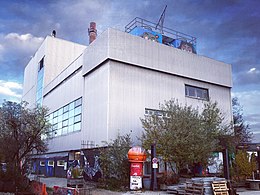Natraj Temple
Natraj Temple [ natˈrɑːʒ ˈtem.pəl ] was a Goa and Techno club in Munich that existed from October 1996 to 2008.
history
The club, usually only briefly referred to as Natraj in parlance , was one of the 1990s , alongside the Tresor and the E-Werk in Berlin, the Dorian Gray and the Omen in Frankfurt, and the Ultraschall , the KW - Das Heizkraftwerk and the Millennium in Munich most famous clubs of techno culture in Germany and was considered an international center of the Goa scene .
meaning
The importance of the Natraj Temple for techno culture results from the fact that it is one of the few techno clubs that specializes completely in one genre, in this case Goa (also: psytrance ). In the Goa scene, decorations based on Hindu, Buddhist or shamanic motifs and symbols, as well as spirituality and often excessive intoxication play an important role. Accordingly, the media mostly focused on the psychedelic design of the club, the elaborate art installations and the alternative scene audience. The Spiegel describes the Natraj Temple as a place "in which many brightly colored cloths decorate the high walls and long-haired people can smoke their joints in the purple light and Indian music". The Süddeutsche Zeitung described the interior of the club as "a ghost train atmosphere, fluorescent cobwebs, an Indian, four-armed goddess rotates in the semi-darkness", and reported on women sitting cross-legged, visitors who talked for hours with the club's decoration, and of "Goa freaks, who left the Natraj Temple half-naked and barefoot in the dead of winter, wallowed in the snow and then called for the ambulance ". In addition to the musical specialization in Goa and trance, the artistic design of the club was often the central theme in travel guides and cultural guides. In the Kulturverführer München there is a dragon above the dance floor, "cuddly pillows in mysterious niches" and an intense color palette for the decoration. With these peculiarities, the Goa Club made a name for itself outside of the scene throughout Europe.
Program and festivals
The club's musical program focused on electronic music of the styles Goa-Techno and Psychedelic Trance. International DJs and live acts often played in the Natraj Temple. Regular events had names like Psychedelic Trance and Special Experience . The Natraj Temple exhibited regularly own Lovemobiles at the Munich Technoparade Union Movement and was known on this also for the elaborate and psychedelic design of the car. The club also organized open air festivals under the name Natraj Summer Dance .
Building the club
The club was located in the Kunstpark Ost in Munich's Berg am Laim district in a disused factory building. It consisted of a main area with the dance floor, which one floor above was surrounded by a large gallery with the so-called chill-out area, as well as an adjoining bar room with a kiosk, in which, in addition to drinks, exotic spices were sold. In 2003 the Natraj Temple moved to the premises of the K41 club , and again in 2007 to the premises of the former Octagon .
Others
The club regularly published compilations with names like Natraj Summer Dance or Winterdance .
Web links
- Official website of the Natraj Temple ( Memento of March 28, 2002 in the Internet Archive )
- Detailed description of the club
- Report in the Süddeutsche Zeitung
- Natraj Temple virtual
Individual evidence
- ↑ Paulina Thillmann: Germany Map: Legendary clubs. In: Zeitmagazin . November 29, 2017. Retrieved June 23, 2019 .
- ↑ cf. Ronald Hitzler , Michaela Pfadenhauer: A post-traditional community: integration and distinction in the techno scene . In: Frank Hillebrandt, Georg Kneer , Klaus Kraemer (eds.): Loss of security? Lifestyles between multiple options and scarcity . VS Verlag für Sozialwissenschaften 1998 / Springer-Verlag 2013, ISBN 978-3-531-13228-0 , p. 85, 4th footnote , doi : 10.1007 / 978-3-322-83316-7 .
- ↑ Country: Germany. In: Mushroom Magazine. May 1, 2013, accessed March 4, 2017 .
- ^ Klaus Brinkbäumer: Youth scene: Art instead of dumplings. In: Der Spiegel . February 22, 1999, accessed March 1, 2017 .
- ↑ David Weigend: Techno in Munich: Deadly said rave longer. In: Süddeutsche Zeitung . May 11, 2010, accessed March 1, 2017 .
- ^ A b c Rolf Hosfeld , Veruschka Götz, Franz Kotteder : Kulturverführer München . 2nd updated edition. Helmut Metz Verlag, Hamburg 2005, ISBN 978-3-937742-08-3 , pp. 88 .
- ↑ Andreas Ascher: Nelles Guide: Munich . 3rd revised edition Edition. Nelles Verlag GmbH, Munich 1998, ISBN 978-3-88618-120-9 (English).
- ^ Valerie Conners et al .: MTV Europe (MTV Guides) . 1st edition. John Wiley & Sons , Hoboken, New Jersey 2006, ISBN 978-0-7645-8499-2 (English).
- ^ A b Francis Söder: Hall culture and event instead of monument and industrial culture . In: Thomas Kaestle, Manfred Walz, Ovis Wende (eds.): Art + planning = urbanity? Brownfields between urban development and urban art . FH Dortmund, 2006, p. 74-75 .
- ^ A b Natraj Temple - Psychodelic experience. In: munichx. Retrieved March 1, 2017 .
- ↑ a b cf. Database on scene portal Goabase.net. Retrieved March 1, 2017 .
- ↑ Natraj Temple on Munich-Party.de. Retrieved March 1, 2017 .
- ^ Jochen Temsch: Nightlife II: Happy witching hour. In: Süddeutsche Zeitung . September 8, 2003, accessed March 1, 2017 .
- ↑ Natraj is moving. In: Partysan . February 26, 2007, archived from the original on December 19, 2014 ; accessed on March 1, 2017 .
- ^ Zinc Media, Inc: Natraj Temple. In: Discogs . Retrieved January 3, 2017 .
